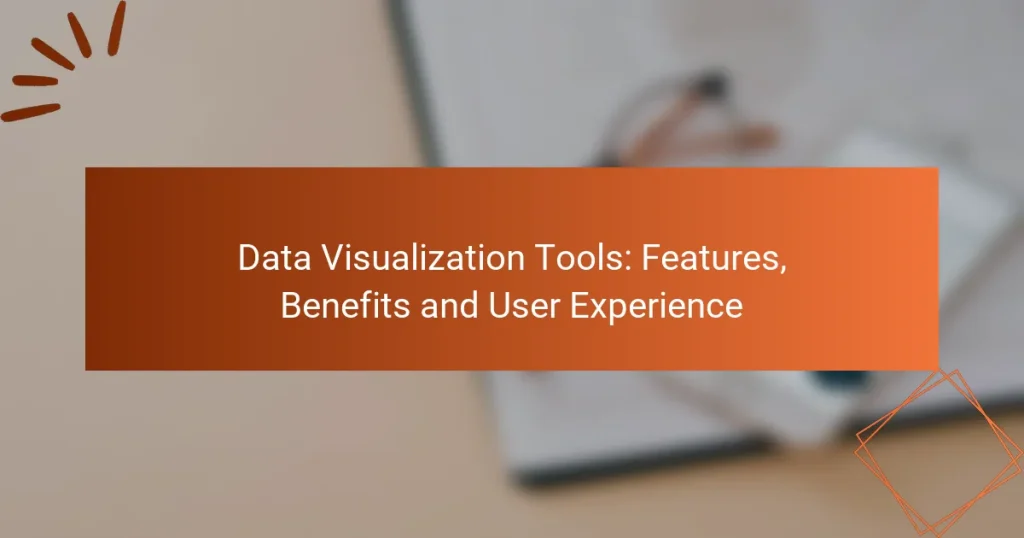Data visualization tools are essential for transforming complex data sets into clear, insightful visual representations that facilitate informed decision-making. With user-friendly interfaces and powerful features, tools like Tableau, Microsoft Power BI, and Google Data Studio enable users to create interactive dashboards and customizable visualizations. By prioritizing usability and real-time data integration, these tools enhance the overall data analysis experience, driving strategic improvements across organizations.
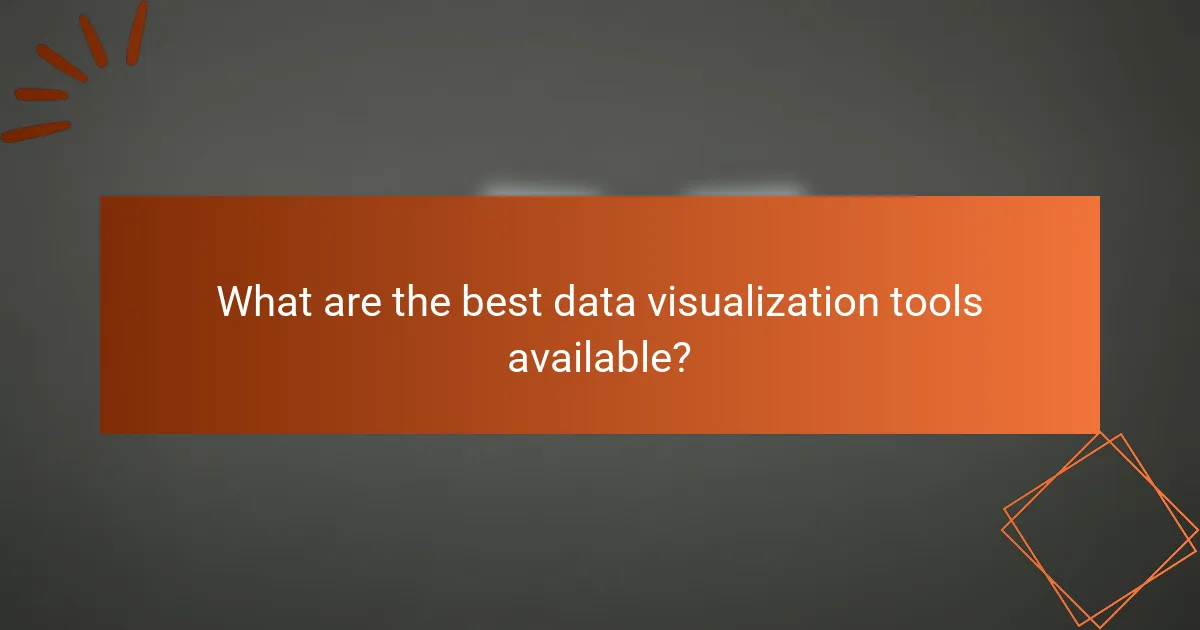
What are the best data visualization tools available?
The best data visualization tools combine user-friendly interfaces with powerful features to help users create insightful visual representations of data. Popular options include Tableau, Microsoft Power BI, Qlik Sense, Google Data Studio, and Looker, each offering unique strengths and capabilities.
Tableau
Tableau is renowned for its intuitive drag-and-drop interface, allowing users to create complex visualizations without extensive programming knowledge. It supports a wide range of data sources, making it versatile for various industries.
One of Tableau’s key features is its ability to handle large datasets efficiently, enabling real-time data analysis. Users can create interactive dashboards that can be shared across teams, enhancing collaboration and decision-making.
Microsoft Power BI
Microsoft Power BI integrates seamlessly with other Microsoft products, making it a preferred choice for organizations already using tools like Excel or Azure. It offers robust data modeling capabilities and a variety of visualization options.
Power BI’s pricing is competitive, with a free version available that includes essential features, while the Pro version provides advanced functionalities. Users appreciate its ability to publish reports to the cloud for easy access and sharing.
Qlik Sense
Qlik Sense stands out for its associative data model, allowing users to explore data freely without predefined queries. This feature enables deeper insights as users can uncover hidden relationships within the data.
Additionally, Qlik Sense offers a strong focus on self-service analytics, empowering users to create their own reports and dashboards. Its mobile capabilities ensure that insights are accessible on the go, making it suitable for dynamic business environments.
Google Data Studio
Google Data Studio is a free tool that provides a simple way to create interactive reports and dashboards using data from various Google services and external sources. Its user-friendly interface is ideal for beginners and those looking to visualize data quickly.
One of its strengths is the ability to collaborate in real-time with team members, making it easy to share insights. However, its functionality may be limited compared to more advanced tools, making it best suited for smaller projects or businesses.
Looker
Looker is a cloud-based data platform that emphasizes data exploration and business intelligence. It allows users to create custom data models and visualizations tailored to their specific needs.
Looker’s integration with modern data warehouses enhances its performance and scalability, making it suitable for organizations with large datasets. While it requires some technical expertise to set up, its powerful analytics capabilities can drive significant business insights.

What features should I look for in data visualization tools?
When selecting data visualization tools, prioritize features that enhance usability and effectiveness. Key aspects include interactive dashboards, real-time data integration, customizable visualizations, and collaboration capabilities, which collectively improve data analysis and decision-making processes.
Interactive dashboards
Interactive dashboards allow users to engage with data dynamically, providing a more intuitive experience. Look for tools that enable filtering, drilling down into data points, and adjusting views on the fly. This interactivity helps users uncover insights quickly and tailor their analysis to specific needs.
For example, a marketing team might use an interactive dashboard to visualize campaign performance, enabling them to filter results by date, region, or demographic. This flexibility enhances the decision-making process by presenting relevant data in real-time.
Real-time data integration
Real-time data integration ensures that the visualizations reflect the most current information available. This feature is crucial for businesses that rely on timely data for operational decisions, such as financial trading or inventory management. Look for tools that can connect seamlessly with various data sources, including databases, APIs, and cloud services.
For instance, a retail company might utilize real-time integration to monitor sales data as it happens, allowing them to adjust inventory levels instantly. This capability can significantly improve responsiveness and operational efficiency.
Customizable visualizations
Customizable visualizations enable users to tailor charts, graphs, and maps to fit their specific data storytelling needs. This feature is essential for presenting complex data in a clear and engaging manner. Ensure the tool offers a variety of visualization types and allows for adjustments in colors, labels, and layouts.
Consider a healthcare provider that needs to display patient data trends; customizable visualizations can help them create specific charts that highlight key metrics, making the information more accessible to stakeholders.
Collaboration capabilities
Collaboration capabilities facilitate teamwork by allowing multiple users to work on the same data visualizations simultaneously. This feature is vital for organizations where cross-departmental collaboration is necessary for effective data analysis. Look for tools that support sharing, commenting, and version control to enhance collaborative efforts.
For example, a project team might use a data visualization tool to collectively analyze project performance metrics, enabling them to share insights and make informed decisions together. Effective collaboration can lead to more comprehensive analyses and better outcomes.
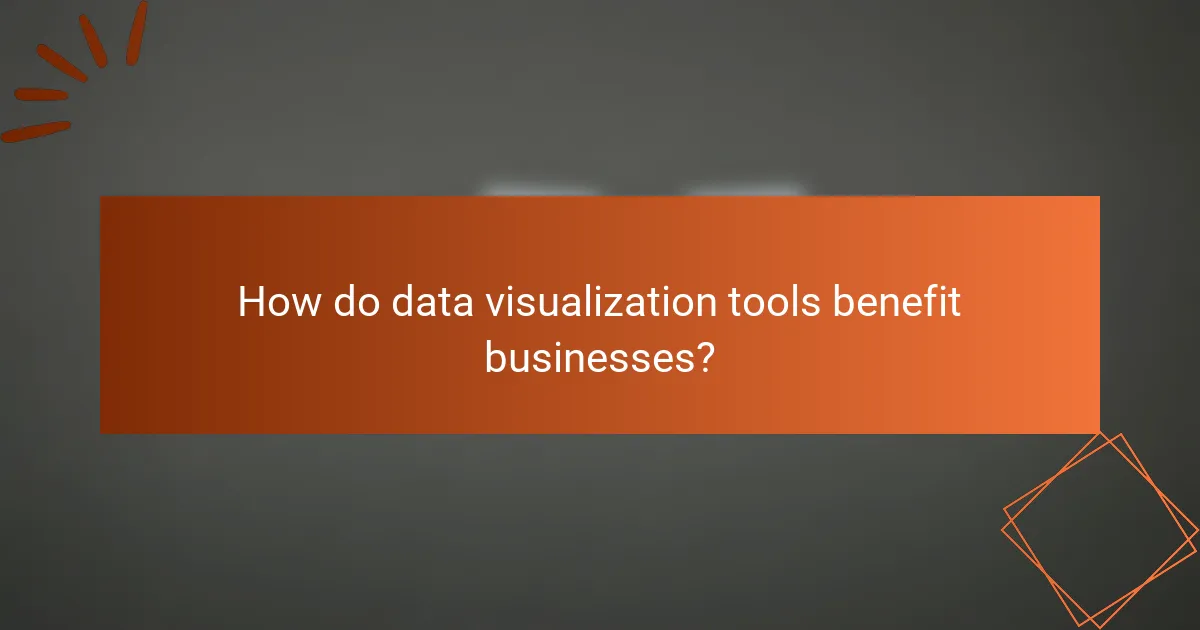
How do data visualization tools benefit businesses?
Data visualization tools provide businesses with the ability to interpret complex data sets quickly and effectively, leading to informed decisions. By transforming raw data into visual formats, organizations can uncover insights that drive strategy and operational improvements.
Improved decision-making
Data visualization tools enhance decision-making by presenting data in an easily digestible format. Visual representations, such as charts and graphs, allow stakeholders to identify trends and patterns that might be overlooked in traditional reports. This clarity helps teams make timely and informed choices based on real-time data.
For instance, a sales team can use visual dashboards to track performance metrics and adjust strategies promptly, ensuring they meet targets. The ability to visualize key performance indicators (KPIs) can significantly reduce the time spent analyzing data.
Enhanced data storytelling
Data visualization tools facilitate enhanced storytelling by allowing businesses to convey narratives through data. By combining visuals with contextual information, organizations can create compelling stories that resonate with their audience, whether they are internal teams or external clients.
For example, a marketing team can illustrate the impact of a campaign through visual analytics, showcasing customer engagement and conversion rates. This storytelling approach not only informs but also persuades stakeholders to support strategic initiatives.
Increased efficiency
Using data visualization tools can lead to increased efficiency in data analysis and reporting processes. By automating the creation of visual reports, teams can save significant time that would otherwise be spent on manual data manipulation and formatting.
Moreover, these tools often allow for real-time updates, meaning that decision-makers have access to the most current data without delay. This immediacy can streamline workflows and enhance productivity across departments.
Better data accessibility
Data visualization tools improve data accessibility by making complex information understandable to a broader audience. Users with varying levels of data literacy can engage with visual formats, breaking down barriers to data interpretation.
For example, a company can provide interactive dashboards that allow employees to explore data relevant to their roles without needing advanced analytical skills. This democratization of data fosters a culture of data-driven decision-making throughout the organization.
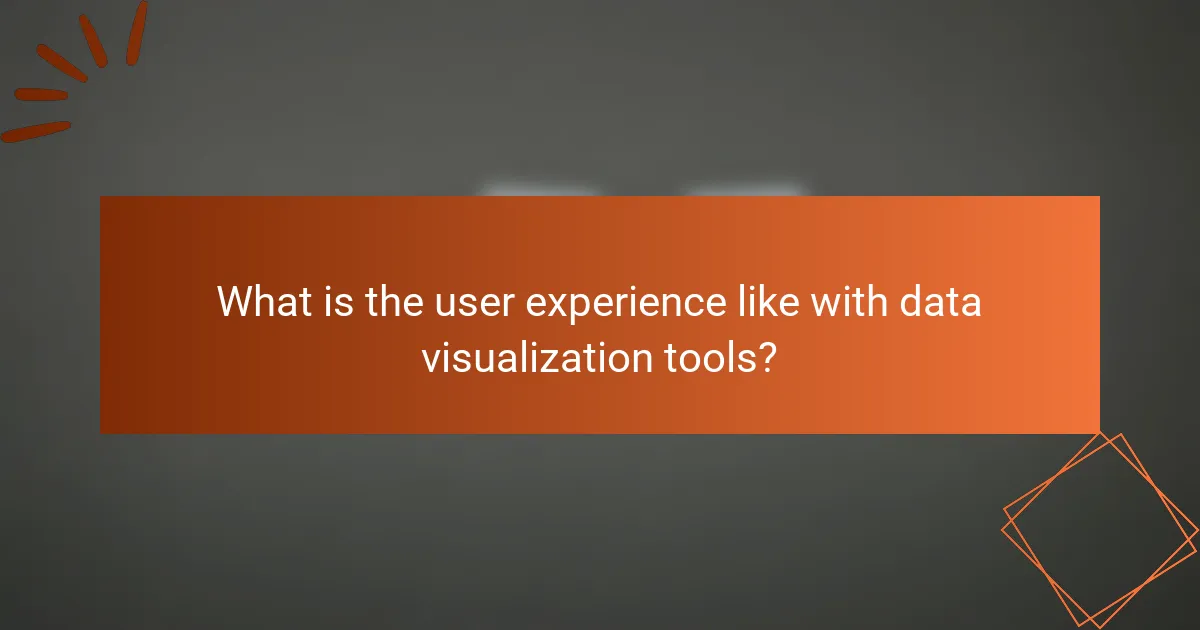
What is the user experience like with data visualization tools?
The user experience with data visualization tools is generally characterized by ease of use, accessibility, and the ability to create insightful visual representations of data. These tools are designed to help users, regardless of their technical background, to analyze and interpret complex datasets effectively.
Intuitive interfaces
Intuitive interfaces are a hallmark of effective data visualization tools, allowing users to navigate and utilize features without extensive training. Many tools employ drag-and-drop functionality, enabling users to easily create charts and graphs by simply selecting data points.
For example, platforms like Tableau and Power BI offer user-friendly dashboards that simplify the process of data manipulation. This design approach minimizes the time spent on learning how to use the tool and maximizes the focus on data analysis.
Learning curve considerations
The learning curve for data visualization tools can vary significantly based on the complexity of the software and the user’s prior experience. Basic tools may require only a few hours to become proficient, while more advanced platforms could take several weeks to master.
To ease the transition, many tools provide tutorials, webinars, and community forums. Users should consider starting with simpler tools to build foundational skills before progressing to more complex options, ensuring a smoother learning experience.
Customer support options
Robust customer support is essential for enhancing the user experience with data visualization tools. Many providers offer multiple support channels, including live chat, email, and phone support, ensuring users can get help when needed.
Additionally, comprehensive knowledge bases and user communities can provide valuable resources for troubleshooting common issues. When selecting a tool, users should evaluate the availability and quality of customer support to ensure they have access to assistance as they navigate the software.
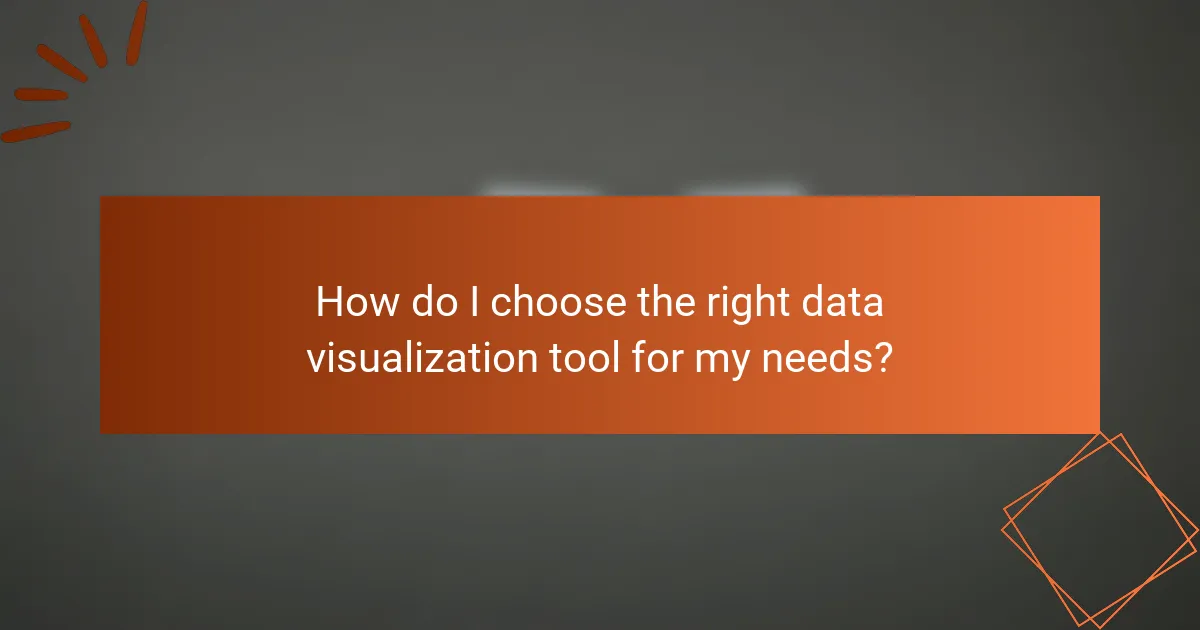
How do I choose the right data visualization tool for my needs?
Choosing the right data visualization tool involves understanding your specific requirements, budget, and user experience preferences. A well-suited tool can enhance data interpretation and decision-making, making it essential to evaluate these factors carefully.
Assessing business requirements
Start by identifying the primary goals of your data visualization efforts. Consider whether you need to create dashboards, reports, or interactive visualizations, as each purpose may require different features. For example, if your focus is on real-time data tracking, look for tools that support live data feeds.
Additionally, assess the types of data you will be visualizing. Some tools excel with specific data formats or sources, such as SQL databases or cloud storage. Ensure the selected tool can integrate seamlessly with your existing data infrastructure.
Evaluating budget constraints
Your budget will significantly influence your choice of data visualization tools. Many options range from free, open-source solutions to premium software with extensive features. Determine what you can allocate for this purpose, keeping in mind that investing in a robust tool can lead to better insights and efficiency.
Consider not only the upfront costs but also ongoing expenses, such as subscription fees or costs for additional features. It’s wise to compare pricing models and assess whether a one-time purchase or a subscription service aligns better with your financial strategy.
Considering user feedback
User feedback is crucial in selecting a data visualization tool, as it provides insights into usability and performance. Look for reviews and testimonials from other users in your industry to gauge their experiences. This can help you identify potential strengths and weaknesses of the tools you are considering.
Additionally, consider conducting a trial or demo of the tool with your team. Gathering input from actual users can highlight specific needs and preferences, ensuring the chosen tool aligns with the team’s workflow and enhances productivity.
